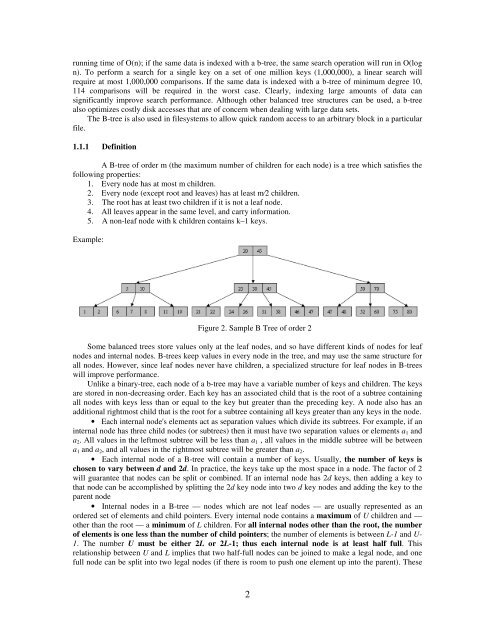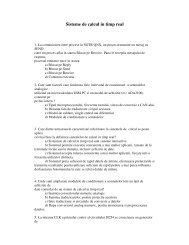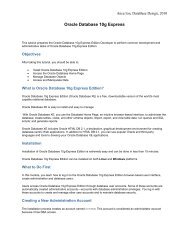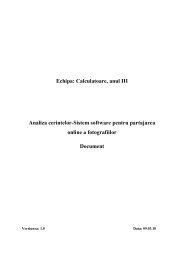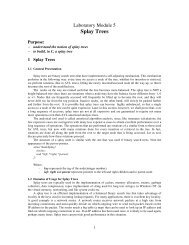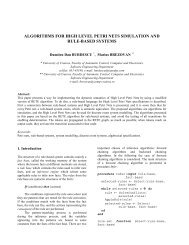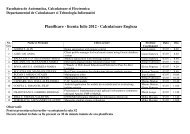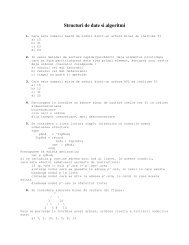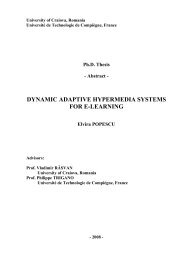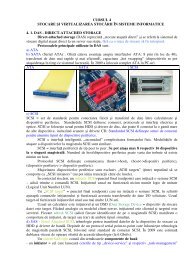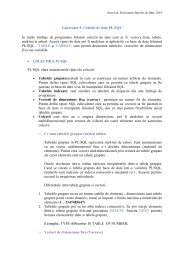You also want an ePaper? Increase the reach of your titles
YUMPU automatically turns print PDFs into web optimized ePapers that Google loves.
unning time of O(n); if the same data is indexed with a b-tree, the same search operation will run in O(log<br />
n). To perform a search for a single key on a set of one million keys (1,000,000), a linear search will<br />
require at most 1,000,000 comparisons. If the same data is indexed with a b-tree of minimum degree 10,<br />
114 comparisons will be required in the worst case. Clearly, indexing large amounts of data can<br />
significantly improve search performance. Although other balanced tree structures can be used, a b-tree<br />
also optimizes costly disk accesses that are of concern when dealing with large data sets.<br />
The B-tree is also used in filesystems to allow quick random access to an arbitrary block in a particular<br />
file.<br />
1.1.1 Definition<br />
A B-tree of order m (the maximum number of children for each node) is a tree which satisfies the<br />
following properties:<br />
1. Every node has at most m children.<br />
2. Every node (except root and leaves) has at least m⁄2 children.<br />
3. The root has at least two children if it is not a leaf node.<br />
4. All leaves appear in the same level, and carry information.<br />
5. A non-leaf node with k children contains k–1 keys.<br />
Example:<br />
Figure 2. Sample B Tree of order 2<br />
Some balanced trees store values only at the leaf nodes, and so have different kinds of nodes for leaf<br />
nodes and internal nodes. B-trees keep values in every node in the tree, and may use the same structure for<br />
all nodes. However, since leaf nodes never have children, a specialized structure for leaf nodes in B-trees<br />
will improve performance.<br />
Unlike a binary-tree, each node of a b-tree may have a variable number of keys and children. The keys<br />
are stored in non-decreasing order. Each key has an associated child that is the root of a subtree containing<br />
all nodes with keys less than or equal to the key but greater than the preceding key. A node also has an<br />
additional rightmost child that is the root for a subtree containing all keys greater than any keys in the node.<br />
• Each internal node's elements act as separation values which divide its subtrees. For example, if an<br />
internal node has three child nodes (or subtrees) then it must have two separation values or elements a 1 and<br />
a 2 . All values in the leftmost subtree will be less than a 1 , all values in the middle subtree will be between<br />
a 1 and a 2 , and all values in the rightmost subtree will be greater than a 2 .<br />
• Each internal node of a B-tree will contain a number of keys. Usually, the number of keys is<br />
chosen to vary between d and 2d. In practice, the keys take up the most space in a node. The factor of 2<br />
will guarantee that nodes can be split or combined. If an internal node has 2d keys, then adding a key to<br />
that node can be accomplished by splitting the 2d key node into two d key nodes and adding the key to the<br />
parent node<br />
• Internal nodes in a B-tree — nodes which are not leaf nodes — are usually represented as an<br />
ordered set of elements and child pointers. Every internal node contains a maximum of U children and —<br />
other than the root — a minimum of L children. For all internal nodes other than the root, the number<br />
of elements is one less than the number of child pointers; the number of elements is between L-1 and U-<br />
1. The number U must be either 2L or 2L-1; thus each internal node is at least half full. This<br />
relationship between U and L implies that two half-full nodes can be joined to make a legal node, and one<br />
full node can be split into two legal nodes (if there is room to push one element up into the parent). These<br />
2


